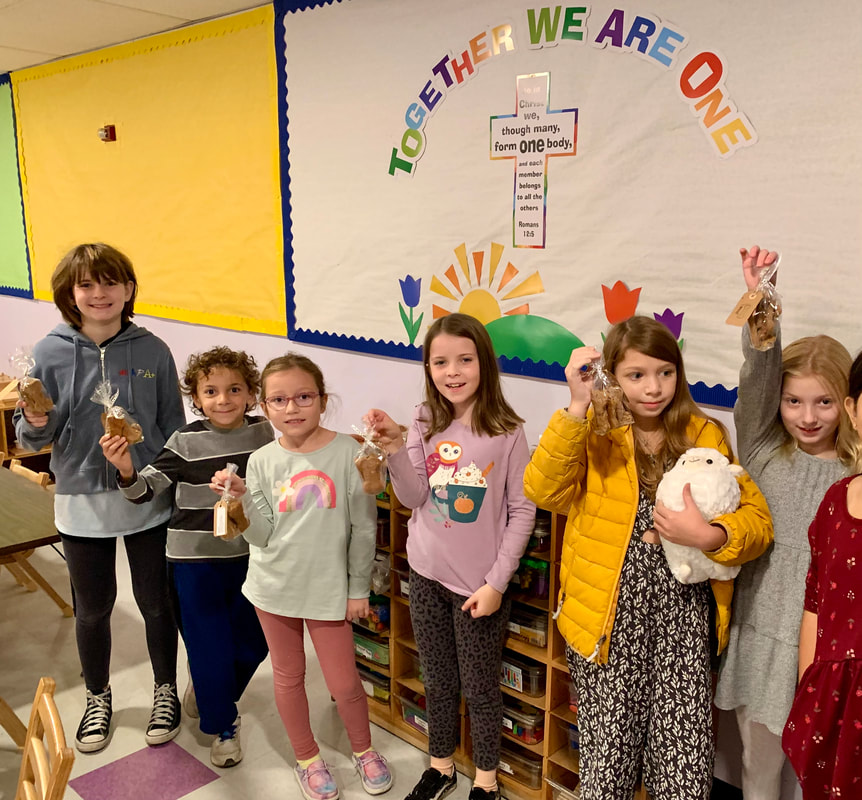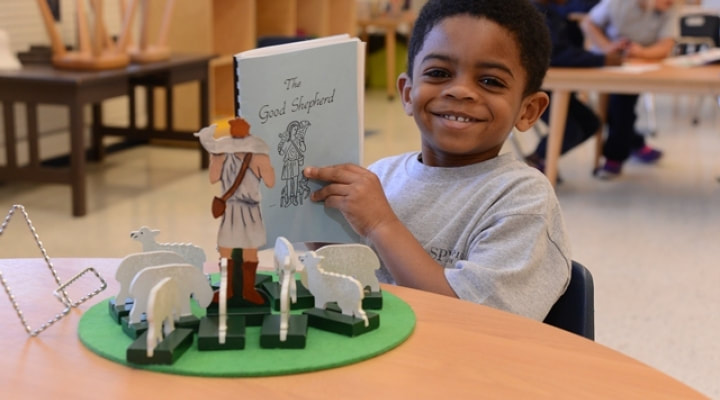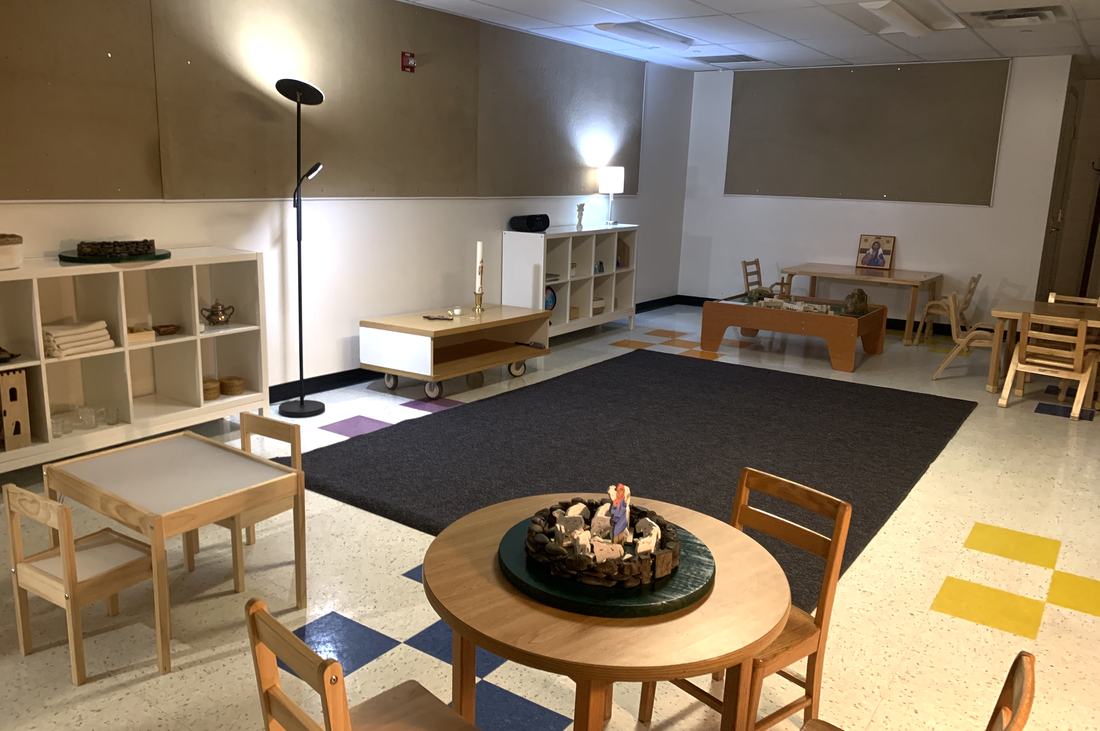|
Last week, the younger group discussed our place in the universe, reflecting on the vastness of God’s creation and our unique and particular role in His plan. It was especially interesting to see an actual photo of the universe as related to where we live right now. Flip through the slides below. Later, we practiced “making a silence”, an exercise that invites children to quiet their minds and foster a sense of inner peace. We live in a noisy world, filled with so many sounds that can drain us emotionally and spiritually. Many of us rarely have the opportunity to experience silence or to savor the quieter sounds of nature around us. During this lesson, children are guided by the teacher to become very still and quiet for a given amount of time. Knowing it’s a challenge (“It takes great strength to make a silence!”), children find this game fun and get a great sense of satisfaction when the entire room is perfectly still. Students also enjoyed some practical life activities, such as silver polishing and grating cinnamon. In the atrium, these activities provide hands-on, concrete experiences that develop practical skills, and nurture concentration and reflection. The older students continued work on the aquaponics project, planting seeds and observing the fish. We also packaged and labeled the dog biscuits which are ready to sell at the Calvary Bazaar!
0 Comments
Last week, Miss Elsa’s class learned about the liturgical calendar and the significance of the colors. Liturgical colors and the liturgical calendar are important in our faith because they help us understand and celebrate the different seasons of the Church year. We use different colors like purple, white, green, red, and more to help us feel and remember the meaning of each time in the Church calendar. For example, we use purple during Advent and Lent to remind us to prepare and reflect. White (or Gold) is for times of celebration, like Christmas and Easter, signifying joy and purity. Green represents ordinary time when we learn more about Jesus' teachings. These colors help us connect with God's story in a colorful way, guiding us through the seasons of our faith, just like how nature changes throughout the year. We spent time working with the liturgical calendar puzzle and then reflected on the colors of the fall season and how the beauty of creation reminds us of God’s infinite love. The older group began with a discussion about God as our maker, the One who has created the whole universe in order to love it all. We then reflected on how each and everyone one of us is unique--there’s never been anyone like you in God’s whole creation! Fingerprinting was a fun and tangible way to emphasize this point. We also began working on our aquaponics project, a fascinating reminder of the splendor and interconnectedness of all life. Almighty God, thank you for making the whole universe and us. May we feel your love in our whole being and know in our minds and hearts that we are created by love and for love. Amen.
Last week, students reflected on the life of St. Francis of Assisi, emphasizing his deep affection for all of God's creations. Even the birds were drawn to him, eager to listen to his messages of love. The younger group created bird treats designed to be hung on tree branches. They also discussed ways to promote mutual care for one another, as well as for animals and the environment. The older students discussed saints as “the lights of the world in every generation,” people whose lives and deeds have shone brightly and helped others more closely follow God. There are saints who lived long ago and there are saints living and working in the world today, saints who are known by the church and saints who are known only to God. We say that the church—we—are part of the Communion of Saints, the company of all faithful people, connected through our baptism to those Christians who have died, those who are alive now, and those who haven’t yet been born. In the Episcopal Church we have a Calendar of Saints, holy men and women we remember in prayer and with readings from the Bible on their feast day. We spent the remainder of the time in the kitchen making dog biscuits to sell at the Calvary Bazaar at the end of the month. Thank you to Miss. Adele for leading this activity! When we are with children between the ages of three and six, we are really with persons in a different world. Children live in a different religious world. The way they live their relationship with God is quite different than ours. All of us know, for instance, that it is not possible to speak with a child of three about God as we would with an adult, and this can make things difficult for us. Let us pause a while and step into their world.
One special feature of the religious life of children is the joy they are capable of when they are helped to draw near to God. They feel a particular kind of joy. Many things make children happy, but there are different qualities of happiness. There is a kind of happiness that is more a state of “emotional excitement” and often leads to nervousness, fatigue, and irritability. The happiness they feel when they come close to God is a quality of joy that makes them peaceful, relaxed, as if something very deep has been struck in their heart and they go on listening to this sound in the depths of their heart. It is like the response of someone who has found a life-giving place and, having found it, does not want to leave. It is the kind of joy that involves children completely. After some children and I had prayed for a rather long time together, a little girl, Stefania, said, “My body is happy.” It was as if she felt a physical joy in being with God. Children are totally involved in what they live. There is nothing left out when they pray or they hear the words of God. There is always a response of this kind of joy when children listen to the Good Shepherd parable. They give the impression of being so comfortable with the Good Shepherd. The ease and spontaneity of young children’s religious expressions and feelings spring from the depth of their hearts, as if it were completely natural to them. These joyful responses are very significant since nothing is more gratifying than the satisfaction of a vital need. They tell us that religious formation is not something we impose. The religious experience is so deep and the serenity it gives is so great that it responds to a vital need in the child. When we help the child to encounter God we are responding to the child’s unspoken request: “Help me to come close to God. Help me to be fully who I am.” Cavalletti, Sofia. The Good Shepherd and the Child: A Joyful Journey, Revised and Updated (pp. 22-23). © The United States Association of the Catechesis of the Good Shepherd, Inc. 2023 We are delighted to have a newly arranged, dedicated space for our children’s faith formation program this year! This space, called an atrium, is part of our Montessori-based children’s faith formation program called Catechesis of the Good Shepherd (CGS). CGS is centered on the concept that God is present in a child’s deepest being and that God and the child are already in a unique and loving relationship. With hands-on materials, sacred stories, and the guidance of loving catechists, our children have the opportunity to develop a profound relationship with God at their own pace and in a way that speaks directly to their young hearts. The word “atrium” typically refers to a “portico, or porch entrance to a large house.” In the ancient church, the Atrium was a gathering place where those preparing to enter the Church would receive instruction. The Atrium has a similar purpose for our children as it is a place to help them enter into the life of God and the Church. The CGS Atrium contains materials for hands-on learning which are simple and beautiful such as dioramas, small figures of biblical people, and geography materials such as the map of Israel and the City of Jerusalem. It is purposely structured not as a classroom, but a place in which the spiritual life can be lived. How You Can HelpWe are continually adding to and improving our Atrium at Calvary. If you are interested in sourcing and creating materials (e.g. sewing, wood working, painting etc) or helping as a catechist or volunteer, please contact Vicki at vrispoli@calvarypgh.org or (210) 315-2704. To learn more about Catechesis of the Good Shepherd (CGS) visit http://www.cgsusa.org/
What a gift to begin again! It has been wonderful to see everyone back at Faith Formation. Miss Elsa's class listened to the Parable of the Good Shepherd and discussed key points, such as Jesus' deep love and care for each one of us, His willingness to protect and sacrifice for us, and how we, as His sheep, recognize His voice and follow Him. The lesson also emphasized the unity we will experience in His sheepfold and how the love within the Holy Trinity serves as the foundation for the Good Shepherd's love for us. The older group discussed the Feast of Saint Michael and All Angels, and reflected on the conventional artistic depictions of angels across different cultures. We also spent some time outside, enjoying the beautiful fall day in the garden. We’re excited for another great year of learning and growing together! |
Location |
|



 RSS Feed
RSS Feed